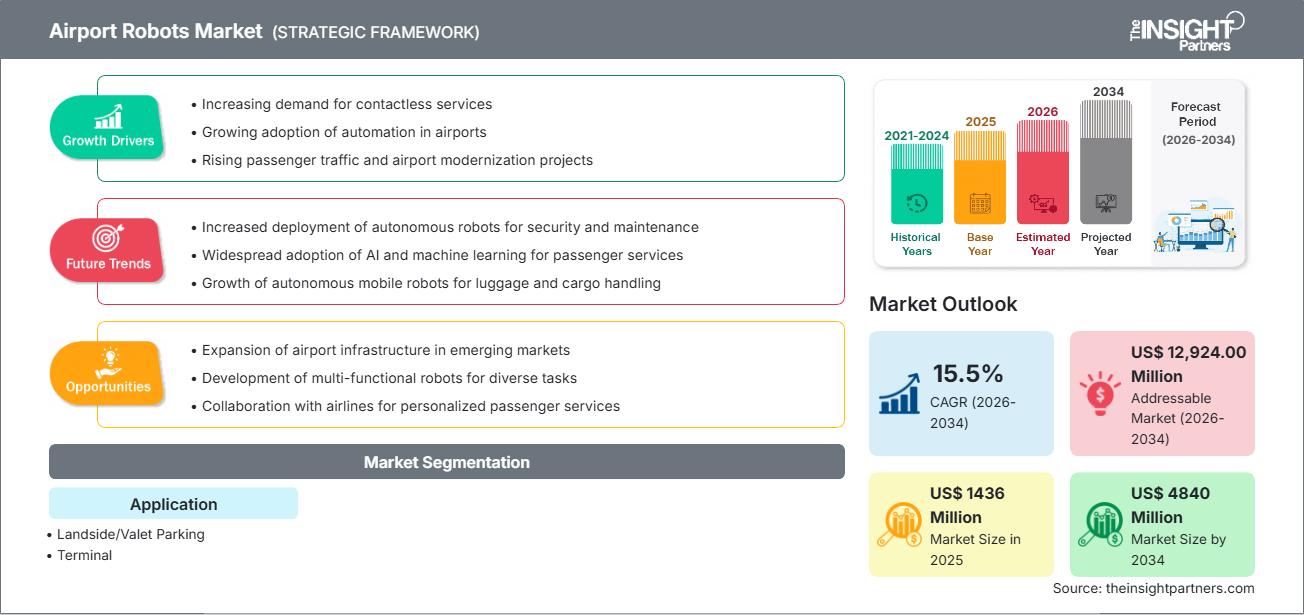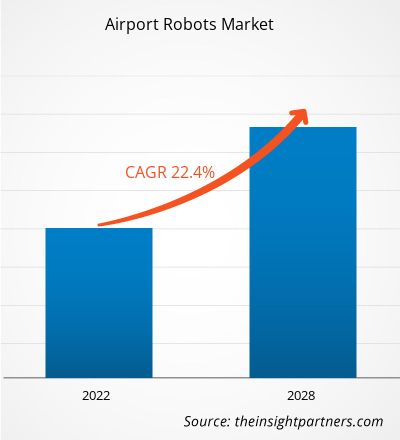공항 로봇 시장 규모는 2025년 14억 3,600만 달러에서 2034년 48억 4,000만 달러로 성장할 것으로 예상되며, 예측 기간(2026~2034년) 동안 연평균 15.5%의 성장률을 기록할 것으로 전망됩니다.
공항 로봇 시장 분석
공항 자동화 증가, 보안 인식 제고, 인건비 압박, 그리고 승객 경험 개선에 대한 요구 증가는 공항 로봇 시장의 급속한 성장을 견인할 것입니다. 공항들은 승객 지원, 청소, 수하물 처리, 심지어 보안까지 다양한 분야에 서비스 로봇을 도입하여 인력 의존도를 줄이고 원활한 운영을 보장하고 있습니다. 인공지능(AI), 컴퓨터 비전, 얼굴 인식, 그리고 향상된 센서 기술의 통합은 이러한 성장을 더욱 가속화할 것입니다.
또한, 전 세계, 특히 신흥 시장에서 공항 인프라에 대한 강력한 투자와 정부의 현대화 계획이 지속적인 수요 증가를 견인하고 있습니다. 로봇은 운영 효율성을 향상시킬 뿐만 아니라 안전 및 위생 개선에도 기여하는데, 이는 코로나19 이후 시대에 더욱 중요해졌습니다.
공항 로봇 시장 개요
공항 로봇은 공항 내에 배치되어 승객 안내, 보안 검색, 수하물 처리, 청소 등 다양한 운영 업무를 수행하는 특수 자율 또는 반자율 로봇 시스템입니다. 이러한 로봇은 반복적이고 자원 집약적인 여러 프로세스를 자동화하여 서비스 효율성을 높이고 인력과 운영 위험을 줄이는 데 도움을 줍니다.
승객 수 증가와 비접촉식의 원활한 공항 경험에 대한 기대가 높아짐에 따라, 이러한 로봇 시스템은 공항 운영 방식을 현대화하는 데 중요한 역할을 합니다. 로봇 시스템 도입은 정보 키오스크 및 안내와 같은 승객 경험의 최전선 영역부터 청소, 감시, 물류와 같은 후방 운영 영역까지 포괄합니다.
이 보고서를 귀하의 요구사항에 맞게 맞춤 설정하십시오.
모든 보고서에 대한 맞춤형 서비스(본 보고서의 일부 내용, 국가별 분석, Excel 데이터 팩 포함)를 무료로 제공해 드립니다. 또한 스타트업 및 대학을 위한 다양한 할인 혜택도 누리실 수 있습니다.
공항 로봇 시장: 전략적 고찰

-
이 보고서에서 주요 시장 동향을 확인하세요.이 무료 샘플에는 시장 동향부터 추정치 및 예측에 이르기까지 다양한 데이터 분석이 포함됩니다.
공항 로봇 시장 동인 및 기회
시장 동인:
- 보안 자동화 및 위협 탐지: 보안 위협의 증가로 인해 공항에서는 센서, 카메라, 안면 인식 기능을 갖춘 로봇을 배치하여 인파를 감시하고, 이상 징후를 감지하고, 불법 물품을 검사하고 있습니다.
- 운영 효율성 필수 요건: 공항은 인건비를 절감하고 운영을 최적화해야 한다는 지속적인 압박에 직면해 있습니다. 로봇은 지치지 않고 작업을 수행하여 청소, 수하물 처리 및 감시 분야에서 수작업 인력에 대한 의존도를 줄일 수 있습니다.
- 인프라 확장 및 현대화: 많은 정부가 공항 건설 또는 확장에 투자하고 있으며, 이는 공항 설계 초기 단계부터 로봇 기술을 통합할 수 있는 기회를 제공합니다. 예를 들어, Insight Partners 보고서는 중국과 인도와 같은 국가의 신규 공항 건설이 중요한 성장 동력이라고 지적합니다.
시장 기회:
- 신흥 시장의 성장: 신흥 경제국의 빠른 발전과 공항 수용 능력 증가는 로봇 도입에 유리한 환경을 제공합니다.
- AI 및 비전 통합: 내비게이션, 음성 상호 작용 및 군중 분석에 AI를 활용하면 공항 로봇의 지능을 높이고 승객 응대 역할에서의 활용도를 향상시킬 수 있습니다.
- 서비스 혁신: 다국어 승객 지원, 자율 수하물 운반, 청소 및 자율 발렛 파킹 로봇과 같은 활용 사례를 확장할 수 있는 잠재력이 있습니다.
- 로봇 OEM 업체와의 파트너십: 공항은 로봇 제조업체 및 AI 기업과 협력하여 공항 구조, 승객 특성 및 규제 요건에 최적화된 맞춤형 로봇 솔루션을 공동 개발할 수 있습니다.
공항 로봇 시장 보고서 세분화 분석
아래의 세분화는 Insight Partners의 분석에서 일반적으로 사용되는 구조를 따릅니다.
신청을 통해:
- 지상 주차 / 발렛 파킹
- 단말기
지리학별:
- 북아메리카
- 유럽
- 아시아 태평양
- 남미 및 중앙아메리카
- 중동 및 아프리카
공항 로봇 시장 지역별 분석
인사이트 파트너스의 분석가들은 예측 기간 동안 공항 로봇 시장에 영향을 미치는 지역별 동향과 요인을 자세히 설명했습니다. 이 섹션에서는 북미, 유럽, 아시아 태평양, 중동 및 아프리카, 남미 및 중앙아메리카를 아우르는 공항 로봇 시장 세분화 및 지역별 분석도 다룹니다.
공항 로봇 시장 보고서 범위
| 보고서 속성 | 세부 |
|---|---|
| 2025년 시장 규모 | 미화 14억 3,600만 달러 |
| 2034년 시장 규모 | 미화 48억 4천만 달러 |
| 글로벌 연평균 성장률(2026년~2034년) | 15.5% |
| 역사적 데이터 | 2021-2024 |
| 예측 기간 | 2026-2034 |
| 포함되는 부문 |
신청을 통해
|
| 대상 지역 및 국가 |
북아메리카
|
| 시장 선도 기업 및 주요 기업 프로필 |
|
공항 로봇 시장 참여자 밀도: 비즈니스 역학에 미치는 영향 이해
공항 로봇 시장은 소비자 선호도 변화, 기술 발전, 제품 이점 인식 제고 등 여러 요인으로 인한 최종 사용자 수요 증가에 힘입어 빠르게 성장하고 있습니다. 수요가 증가함에 따라 기업들은 제품군을 확장하고, 소비자 요구를 충족하기 위한 혁신을 추진하며, 새로운 트렌드를 활용하여 시장 성장을 더욱 촉진하고 있습니다.

- 공항 로봇 시장의 주요 업체 개요를 확인하세요
지역별 공항 로봇 시장 점유율 분석
Insight Partners의 보고서는 지역별 수요 변동 추이를 보여줍니다.
북아메리카
- 시장 점유율 및 중요성: 탄탄한 항공 인프라, 높은 보안 기준, 그리고 높은 1인당 기술 지출 덕분에 역사적으로 도입률을 선도해 왔습니다.
- 주요 동인: 규제 준수, 인건비 압박, 승객 접점 및 후방 운영 부문에 로봇 기술 통합.
유럽
- 시장 점유율 및 중요성: 첨단 공항과 높은 안전 및 규제 기준 덕분에 강력한 입지를 확보하고 있습니다.
- 주요 동인: 공항 운영의 자동화, 지속가능성 및 효율성에 중점을 둡니다.
아시아 태평양
- 성장 전망: 빠른 공항 인프라 개발, 견조한 여객 증가, 그리고 우호적인 정부 정책에 힘입어 고성장 지역으로 전망됩니다.
- 동향: 승객 지원, 보안 및 청소 분야에 인공지능 기반 로봇 도입 증가, 로봇 회사와의 협력 확대.
남미 및 중앙아메리카
- 시장 잠재력: 성장하는 항공 산업 부문; 신규 공항 건설 또는 модернизация에 따른 로봇 기술 도입 가능성.
중동 및 아프리카
- 기회: 야심찬 공항 확장 계획; 대규모 승객 처리 및 보안을 위한 첨단 공항 기술에 대한 관심 증가.
공항 로봇 시장 참여자 밀도: 비즈니스 역학에 미치는 영향 이해
관찰된 경쟁 전략:
- 공항과 로봇 제조업체 간의 파트너십을 통해 맞춤형 로봇을 공동 개발합니다.
- 개입을 최소화하면서 가치를 극대화하는 더욱 자율적이고 인공지능 기반의 로봇 개발.
- 상호 운용성 강조: 로봇을 공항 관리 시스템, 보안 프로토콜 및 승객 데이터 시스템과 통합합니다.
- 엄격한 항공 규정을 충족하기 위해 로봇의 신뢰성, 배터리 수명 및 안전 인증을 강조하십시오.
기회 및 전략적 움직임:
- 공급업체는 정부와 협력하여 공항 현대화 프로그램에 참여할 수 있습니다.
- 고객 경험 향상 및 서비스 차별화를 위해 다국어 지원이 가능한 승객 응대 로봇을 공동 개발합니다.
- 로봇 비용(하드웨어 + 소프트웨어)을 줄이기 위한 연구 개발에 투자하여 소규모 공항에서도 로봇 도입이 경제적으로 실현 가능하도록 합니다.
시장의 주요 참여자:
- 유진 로봇 주식회사
- 아비드봇 주식회사
- 사이버다인 주식회사
- 소프트뱅크 로보틱스
- 스탠리 로보틱스 SAS
- 시타
- ABB 주식회사
- ECA 그룹
- LG전자
조사 과정에서 분석된 기타 시장 참여자는 다음과 같습니다.
- 유니버설 로봇 A/S
- 지멘스 AG
- 탈레스 그룹
- 반더란데 산업
- 보스턴 다이내믹스
- 허니웰 인터내셔널 주식회사
- 쿠카 AG
- 블루보틱스 SA
- UVD 로봇
공항 로봇 시장 뉴스 및 최근 동향
- Insight Partners의 보고서에 따르면 여러 공항에서 얼굴 인식 및 원격 감지 기능을 갖춘 보안 로봇에 대한 관심과 도입이 증가하고 있습니다.
- 스탠리 로보틱스는 공항 주차장에서 자율 발렛 로봇 시스템을 운영하여 지상 공간을 확보하고 효율성을 높이고 있습니다.
- 아시아 등 신흥 경제국의 공항들은 수용 능력 확대와 비접촉 서비스에 대한 필요성 때문에 승객 지원 및 청소 로봇에 대한 투자를 늘리고 있습니다.
- OEM 업체들은 다양한 승객 프로필에 맞춰 배터리 수명 개선, 향상된 AI 내비게이션, 그리고 다중 모드 상호 작용(음성 + 터치) 기능을 갖춘 차세대 로봇 시스템을 개발하고 있습니다.
공항 로봇 시장 보고서 범위 및 제공 내용
Insight Partners의 "공항 로봇 시장 - 2034년까지 전망" 보고서는 다음 내용을 다룹니다.
- 세계 및 지역 시장 규모 및 전망(2021~2034)
- 시장 역학: 동인, 제약 요인, 기회 및 트렌드
- 코로나19가 공항 로봇 도입에 미치는 영향 평가
- 세분화 분석: 유형별, 적용 분야별, 최종 사용자별, 지역별
- PEST 분석(정치, 경제, 사회, 기술) 및 SWOT 분석
- 경쟁 환경: 시장 집중도, 주요 업체 히트맵, 전략
- 주요 기업에 대한 자세한 기업 프로필: SITA, 소프트뱅크 로보틱스, 스탠리 로보틱스, ABB, LG전자, 사이버다인, 유진 로봇 등
- 과거 분석(2년), 기준 연도, CAGR을 포함한 예측(7년)
- PEST 및 SWOT 분석
- 시장 규모 가치/거래량 - 글로벌, 지역, 국가
- 산업 및 경쟁 환경
- Excel 데이터세트
최근 보고서
사용 후기
구매 이유
- 정보에 기반한 의사 결정
- 시장 역학 이해
- 경쟁 분석
- 고객 인사이트
- 시장 예측
- 위험 완화
- 전략 기획
- 투자 타당성 분석
- 신흥 시장 파악
- 마케팅 전략 강화
- 운영 효율성 향상
- 규제 동향에 발맞춰 대응






















 무료 샘플 받기 - 공항 로봇 시장
무료 샘플 받기 - 공항 로봇 시장